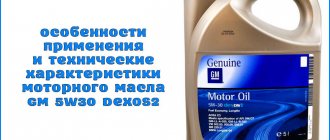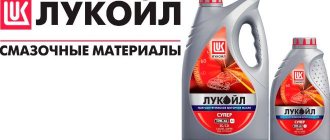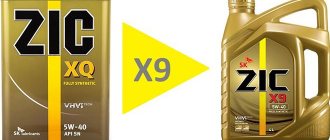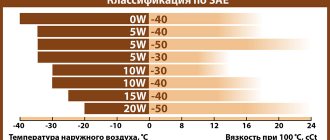What does the marking of 5w30 and 5w40 motor oil mean?
So, the first number from the oil marking indicates its viscosity at low temperatures, the second part indicates the fluidity of the substance in the warm season. This marking of engine oil characterizes it according to the common SAE classification.
The numbers in the marking indicate the type of oil - both types are all-season, which is why it is so popular among motorists. This class of lubricating fluids is universal (all-season) and can be used in engines with any type of fuel at any temperature.
Are oils of the same code different from each other?
Product characteristics may differ slightly from different manufacturers, despite the same labeling. Two "zero" oils with similar properties, produced at different sites, may behave differently depending on conditions. It's all about the set of additives used - they are the ones who give the necessary qualities to the product. Here, the car enthusiast acts at his own risk when determining which motor oil manufacturer is most suitable for his “favorite”.
Total motor oil
Total Quartz 9000 Energy oil is intended for gasoline and diesel engines.
For example, the Total concern offers motorists Total Quartz 9000 Energy, which is indicated for use in any gasoline units and diesel engines. It performs well both on city streets with constant traffic jams and on the freeway. Particularly suitable for a sporty driving style. Advantages:
- extended replacement interval;
- easy start at very low temperatures (-54 °C);
- instant fluidity during cold start;
- reduction in fuel consumption by slightly more than 2%;
- helps reduce emissions of pollutants (carbon dioxide).
Basic indicators:
- kinematic viscosity: (40 °C) - 68.5 cSt; (100 °C) - 12.18 cSt;
- pour point minus 54 °C;
- viscosity index 170.
When developing the product, the manufacturer took into account his solid experience in Formula 1 with its difficult conditions.
Elf Products
The Elf company, part of the same concern, is represented in this group by Excellium LDX lubricant. This universal synthetic motor oil with almost the same properties as Total Quartz is recommended for almost all types of modern engines (including direct injection). The use of oil is optimal for the urban cycle, as well as under increased loads (road, sports). Advantages:
- facilitated cold start of the engine in low-temperature conditions of the year;
- does not freeze even in severe frost;
- in the hot season, the oil does not “burn”;
- noticeably “softens” the operation of the motor;
- ensures excellent cleanliness of the internal components of the unit;
- Can be used for extended oil change intervals.
Basic indicators:
- kinematic viscosity: (40 °C) - 67.6 cSt; (100 °C) - 11.9 cSt;
- pour point minus 60 °C.
Starting the engine when using this oil is not difficult at all; its rotation is absolutely free. In addition, the oil does not “burn”. Of course, provided that the engine is in perfect order. The lubricating characteristics of the product are very high; some craftsmen even manage to use it at home to lubricate mechanical components of household appliances and are also satisfied.
0w30 oil does not burn at high temperatures
In diesel units, oil perfectly removes carbon deposits (this can be noticed when replacing it). Usually, after a couple of changes, the oil retains its transparency for quite a long time.
Mobil oil line
Mobil 1 is also not losing ground. Its Fuel Economy has also earned a lot of praise. Such a property as the ability to help save a little fuel is inherent in it to the same extent as in the above products. This motor oil is designed specifically for the latest models of gasoline and diesel engines that require the use of lubricants with reduced high-temperature viscosity. Its advantages can rightfully include such properties as:
- excellent thermal-oxidative stability;
- reduced oil consumption due to waste;
- fairly high anti-friction.
Kinematic viscosity: (40 °C) - 54.2 cSt; (100 °C) - 10.2 cSt. Fuel Economy has proven itself well both in frosty weather, at ambient temperatures below -30 °C, and in the summer heat. Contrary to the opinions of many drivers, oil consumption does not increase in hot weather; it is quite sufficient from one scheduled change to another.
It is a common belief that when this rather thin oil is used in engines with hundreds of thousands of miles, it may leak. However, practice shows that with proper care of the engine itself, the issue of such “unauthorized” product consumption disappears by itself.
In general, we can talk for a long time about the advantages of using “nulevka”. In the accompanying specifications, the manufacturer always provides a detailed description of the oil and recommendations for its use. Choosing a product from a specific manufacturer is entirely the privilege of the car owner and the capabilities of his wallet. Yes, such motor oil is very expensive. However, confidence in the safety of the “heart” of your favorite car is worth a lot.
Decoding oil 5w30 and 5w40
Viscosity at low temperatures. The viscosity parameter is very important for the machine, since it determines the ability of the lubricant to remain on the surface of the motor for a long time. The most important property of motor oil is described by part 5 of the 5W index, and W means winter. In cold weather, engine oil thickens. The stronger its viscosity, the more force the oil pump works. In these types of oil, the marking has the same first index.
High temperature viscosity. This parameter characterizes the second part of the marking. According to the established SAE classification for grade 5w30 at t 100 °C, the viscosity of the substance will be from 9.3 to 12.6 mm kV/s. For brand type 5w40 from 12.6 to 16.3 mm kV/s. Also, the high-temperature viscosity of the lubricant is characterized by another important indicator: minimum viscosity at shear rate (106 s-1). For 5w30 oil this figure is lower (2.9) than for 5w40 oil, for which this figure is (3.50).
The decoding of 5w40 engine oil is quite simple:
1) 5W indicates the low-temperature viscosity of the substance and allows the car to be started at -35 °C.
2) Subtract 40 from the number in front of W. As a result, the resulting number (-35 ° C) will be the minimum oil temperature, which will allow the internal combustion engine pump to pump it through the system, maximizing the lubrication of the parts.
With such mathematical manipulations, you can easily determine the lowest cranking temperature of the engine. The interpretation of 5w30 oil indicates that this parameter is -30°C. This is not difficult to determine: subtract 35 from the engine starting temperature (5 °C) and it becomes obvious that lowering the oil temperature leads to an increase in its viscosity, and it becomes quite difficult for the starter to crank the engine.
What does winter and summer viscosity mean?
In general, the main characteristic of any motor oil is its fluidity and viscosity. What it is? In fact, this is its ability to spread well throughout the internal cavities of the engine and at the same time stick to the surfaces of parts, forming a protective film on them.
For all-season fluids, both values are of interest. Those. summer and winter. Let's find out what the difference is between them:
- Viscosity at high temperatures. This parameter indicates at what maximum permissible values the lubricating fluid maintains sufficient viscosity. And provides a coating of engine parts with a lubricating film. The higher the number, the thicker the oil. The value is determined based on two parameters - dynamic (at +150 degrees) and kinematic (at +100 degrees) viscosity.
- Viscosity at low temperatures. Quite an important parameter, especially for regions with frosty winters. Determines at what frost the oil ensures normal pumpability.
Those. It would be wrong to fill the engine with lubricant designed to start at a temperature of -20, and start the car at -30. In this case, the effect of oil starvation will occur when the engine runs dry for some time, because the grease will be too thick.
Which engine oil is better 5w30 or 5w40
Motor oil in a car is used for the sole purpose of forming a rich oil film on interacting engine parts. There are very small gaps between such parts in the motor (only a few microns), which require constant high-quality lubrication. Only the manufacturer knows which brand of lubricant is most suitable for each car.
Manufacturing companies, when recommending the use of a certain type, first of all take into account the design features of the power unit itself, and based on these indicators, the characteristics of the oil. Therefore, when choosing oil, it is recommended to follow the manufacturer's instructions.
It is important to consider that, in addition to the common SAE classification, all lubricants must also meet the requirements of the API and ACEA systems. The oil marking according to these classification systems is indicated on the packaging, but does not attract the attention of car owners.
As for popular brands of oil 5w40 or 5w30:
1) Grade 5w40 effectively holds the film, completely eliminating dry friction of parts. It is ideal for modern units with high thermal stress.
2) Oil marked 5w30 has a much lower viscosity and is indispensable in cold weather, as it simplifies engine starting, but in hot weather it becomes too fluid. Under conditions of t 120 – 140 °C in the engine, the viscosity of 5w40 oil is 50% higher than the viscosity of oil marked 5w30.
Is it possible to replace the required 5W-30 with 5W-40?
Motor oils 5w-30 and 5w-40
When choosing high-quality oil for your vehicle, first of all pay attention to the requirements of the car manufacturer. Before the car leaves the factory and is handed over to the new owner, manufacturing companies always study the power plant’s predisposition to various types of motor lubricants. By conducting numerous experiments and changing the load on the internal combustion engine, engineers eliminate unsuitable lubricant compounds and create a list of acceptable oil parameters. If you pour the first fuel and lubricant you come across under the hood, it is better to immediately lock the car and walk: the properties of some lubricants can have a detrimental effect on the condition of the system and leave the car owner without wheels.
After the manufacturer's requirements have been studied, you can return to the main issue. It is possible and even necessary to replace 5W-30 oil with 5W-40 if the car has driven more than one hundred thousand kilometers. Long-term operation causes an increase in gaps between mechanisms, which 5W-30 can no longer cope with: liquid lubricant will leak through the holes and expose structural elements. A thicker lubricant, such as 5W-40, will be able to fill all the spaces and form a reliable layer on the parts. This will reduce engine vibration and protect it from wear.
Note! If 5W-40 is a prohibited viscosity in the instruction manual, then using it in a car is dangerous: serious damage may occur.
There is no need to replace 5W-30 before the first hundred thousand kilometers: due to increased viscosity, increased oil and fuel consumption will occur, so trips will no longer be economical. By the way, they won’t thank you for the excessive thickness of the parts either, because they will have to work with increased load, which will increase their susceptibility to rapid wear.
Engine oil 5w30 or 5w40 – how to choose
It is worth noting that cars with different years of manufacture have their own recommendations regarding the most optimal choice of engine oil. Experts recommend using 5w30 oil if your car is more than seven years old and its mileage does not exceed 70,000 kilometers.
If the car's mileage exceeds this figure, 5w40 oil should be filled in, which is due to the fact that over time the gaps between the elements that make up the engine increase. Therefore, if you previously used oil with a low viscosity, you should switch to 5w40. In addition to viscosity, these motor oils differ in the number of additives.
Professionals also recommend monitoring the car’s reaction to different engine oils. The machine itself will tell you which oil is best suited. For example, on some models of power units, 5w30 oil often cannot withstand increased speeds (torque), which disrupts the stability of its operation. To avoid such situations, it is recommended to use the thickest lubricant in structure.
And finally
There are many car owners on the Internet explaining what will happen if you fill them with 5W40 instead of 5w30. “Every time I pour different oils under the hood, and the car continues to drive without any complaints!” Yes, there are motors that are not picky about the composition of the lubricant - they, as a rule, will not even notice the change. However, most systems react sharply to changing engine oil. At first, the driver will not notice any changes in the car's behavior. Then oily smudges and stains will begin to appear under the car, then starting the engine will take a fraction of a second longer, and then fuel consumption will increase altogether. These symptoms will indicate an incorrectly selected lubricant composition, which is most advisable to change. Have you decided to turn a blind eye to this? This means that serious damage cannot be avoided.
Compatibility of 5w30 and 5w40 oils
There are situations when, in the event of a malfunction, it is necessary to urgently add oil to the engine. As a rule, the lubricant of the exact manufacturer whose product was originally poured into the engine is not always nearby.
The same applies to the oil viscosity index, and therefore you should know whether oils labeled 5w40 and 5w30 can be mixed. It is worth noting that it is often not recommended to mix oil with a fully synthetic mineral oil base oil. It is also not recommended to mix synthetics and semi-synthetics, etc.
As for lubricants marked 5W30/5W40, theoretically these liquids can be mixed with minimal risks only if they are both products from the same manufacturer. Mixing products from different manufacturers is allowed only in an emergency situation, but taking into account that they must have the same basic basis.
From this we can conclude that semi-synthetics are mixed only with semi-synthetics, mineral oil is mixed with a similar product, etc. However, it is impossible to answer unequivocally the question of whether it is possible to add a seemingly analogous 5w30 to an oil marked 5w40, since for For each type of lubricant, manufacturers use their own additive packages, which, after mixing, can react.
Even if there were no consequences in case of emergency topping up of liquids, this is an emergency measure that cannot be used constantly. After eliminating the breakdown, it is necessary to immediately drain the mixed lubricant from the engine and be sure to change the oil filter, and in some cases it may even be necessary to additionally flush the engine before changing the oil.
Let's sum it up
When choosing motor oil, you have to choose a product of one brand or another, and not only the quality of the engine, but also other significant parts of the car often depends on it. Professionals recommend using oil with a higher viscosity, since its use better protects engine parts. Oils of the 5w30 and 5w40 brands are a reliable assistant to the car engine.
Their differences are insignificant; these types of oil are of sufficient quality and meet all European requirements. Using high-quality oil will protect the car’s power unit from breakdowns and allow you to save on repairs or replacement of the engine.











